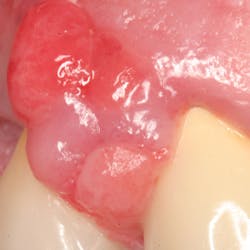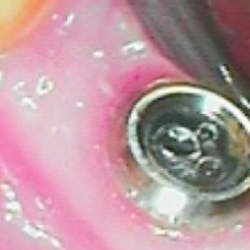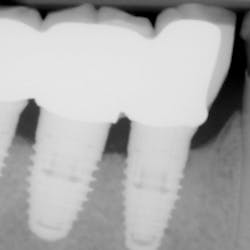By Michael Jaffin, DMD
Chronic periodontitis is an interaction between a plaque biofilm and the body's immune response. A biofilm is a multilayered microbiological ecosystem that adheres to the surface of a structure and confers greater protection from antibiotics and an immune response vs. the planktonic microbiota alone.1,2 Some of the key pathogens in periodontitis are P. gingivalis, T. denticola, T. forsythia, A. actinomycetemcomitans, P. intermedia, C. rectus, as well as other gram-negative rod anaerobes, spirochetes, enteric rods, and beta hemolytic Streptococcus reside in biofilms, making them hard to treat with antibiotics alone.3 The purpose of this article is to better understand the antibiotics that are prescribed for periodontitis, and what effects they have on biofilms and clinical treatment modalities.
Antibiotics have different spectrums and affect microbes in different manners. Amoxicillin is a broad-spectrum penicillin in the beta-lactam family. Beta-lactam antibiotics’ mechanism of action is inhibition of cell wall synthesis. Amoxicillin is drug of choice for Viridens group Streptococci, E. corrodens, F. nucleatum, non-beta-lactamase Prevotella, and Porphyromonas spp. If amoxicillin is taken with clavulanic acid (Augmentin), the spectrum increases to cover beta-lactamase-producing microbes as well.4 Metronidazole is a bacteriocidal nitroimazole. The mechanism of action is that the active moiety damages bacterial and protazoal DNA, leading to cell death. Metronidazole is effective against obligate anerobes such as Porphyromonas spp, Prevotella spp, Bacteroides spp, Fusobacterium spp, and Clostridium spp.4A. actinomycetemcomitans (a noted microbe in aggressive periodontitis) has limited susceptibility to metronidazole; however, when metronidazole is administered in conjunction with amoxicillin, the combination leads to greater cellular uptake of metronidazole, which then leads to a greater effectiveness compared to either antibiotic alone.5
Clindamyacin is a lincosamide antibiotic. It is a bacteriostatic antibiotic that has a mechanism of action that binds to the 23s subunit of the 50s ribosome that prevents bacterial protein synthesis. It is effective against many gram-positive and gram-negative anaerobic and facultative anaerobic bacteria, including Prevotella, Porphyromonas, Eubacteria, and Streptococci spp.4
Tetracyclines (Tetracycline, minocycline, and doxycycline) are broad-spectrum bacteriostatic antibiotics. Their mechanism of action is to bind to the 30s ribosomal subunit and prevent protein synthesis. Tetracyclines have a wide spectrum of both gram-negative and gram-positive bacteria, including spirochetes and A.a — both of which are major players in periodontitis.4 Azythromycin is a macrolide antibiotic. It is bacteriostatic with a mechanism of action of inhibiting protein synthesis by binding to the 50s ribosome. It is effective against gram-positive aerobes and facultative aerobes as well as spirochetes and pigmented anaerobes such as T. forsythia, P. gingivalis, T. denticola, and P. intermedia.4
There are several justifications for using antibiotics in periodontal infections. Several studies have investigated the use of antibiotics as primary intervention for periodontitis. Bacterial counts of P. gingivalis were less after systemic metronidazole; however, these counts were not statistically different than that of placebo.6 A meta analysis was performed on several studies on metronidazole with or without amoxicillin as a monotherapy (without scaling and root planing). The general finding was that antibiotic treatment alone was not a sufficient treatment for periodontitis.2 This is most likely due to the fact that the penetration of the antibiotics into the biofilm was low and that there is higher resistance in the biofilm.2
Organized biofilms have higher resistance to antimicrobials.7 There are several theories on how biofilms gain resistance:
- Molecular signaling/quorum sensing
- Horizontal gene transfer
- Different physiological phases within the biofilm
- The glycocalix acting as a mechanical barrier.8
Disrupting the biofilm mechanically is the gold standard for reducing disease.9 Systemic antibiotics help prevent recolonization and reorganization of the biofilm after the biofilm has been disrupted.6 Many studies evaluate the effect of different antibiotics in conjunction with scaling and root planing.
1. Tetracycline administered as an adjunct to scaling and root planing has shown a pocket reduction greater than scaling and root planing alone. Mean pocket depth reductions were between 0.2 mm and 0.8 mm greater than scaling and root planing alone at six months (2.2 mm to 3.1 mm total reduction) in pockets 4 mm to 6 mm.10 Mean clinical attachment level gain at six months was 0.04 mm to 0.3 mm better than scaling alone (1.06 mm to 1.7 mm net gain).10 If surgical outcomes are included in the meta-analysis, then tetracyline with scaling and root planing with or without replaced flap surgery has a net attachment benefit over the intervention alone of 0.41 mm with a P = 0.003.2
2. Metronidazole alone has shown a mean PD change over scaling and root planing alone ranging from -.02 mm to 0.41 mm (0.46mm to 1.83 mm reduction in PD);10 however, these differences in pocket depth were shown not to have reached statistical significance.8 Clinical attachment level changes in patients taking metronidazole ranged .2 mm to 1.2 mm difference from SRP alone (0.43 mm to 2.45 mm). Metronidazole with amoxicillin after scaling and root planing in patients with chronic periodontitis mean difference in clinical attachment from scaling and root planing alone of 0.46 mm to 0.9 mm.
3. Augmentin with scaling and root planing have not shown to be effective in changes in PD at one year vss SRP alone.11 Cal levels in Augmentin ranged in difference from SRP alone by 0.16 mm to 1.3 mm (1 mm to 2.18 mm total).10
4. Clindamycin with SRP had cal levels 1.6 mm better than SRP alone in sites 6 mm or greater (3 mm change) and 1.4 mm better than SRP alone overall (1.7 mm change).2 Changes in PD ranged from 0.2 mm to 2.3 mm between studies.10
5. Azithromycin and SRP showed a 0.3 mm increase in PD over SRP alone at one year, whereas in sites initially 5 mm or greater, azithromycin showed 0.8 mm better than SRP alone.12 In sites with 6 mm or greater pocket depth, azithromycin and SRP had cal gain over SRP alone of 0.9 mm at one year.12 The microbiologic makeup of the subgingival biofilm at one year after SRP and azithromycin had significantly less red complex bacteria.12 Within one year all other bacterial changes had reverted to near baseline.12
Overall the polymicrobial nature and the host response to the polymicrobial biofilm make each individual’s response to therapy different. Certain biofilms, such as those associated with localized aggressive periodontitis, react to antibiotic treatment.10 The best evidence shows that antibiotics do have some added benefit in treating periodontitis in conjunction with scaling and root planning; however, there needs to be a risk/benefit analysis due to the possible side effects and emerging drug-resistant strains.13
Author bio
Mike Jaffin is a graduate of the SUNY Stony Brook Postgraduate Periodontal Program. He currently is in private practice in New Jersey.
References
1. Marsh PD. Dental plaque: biological significance of a biofilm and community lifestyle. Journal of Clinical Periodontol 2005; 32(Suppl. 6)7-15.
2. Haffajee AD, Socransky SS, Gunsolley JC. Systemic anti-infective periodontal therapy. A Systematic Review. Annals of Periodontology, 2003; 8:115-181.
3. Genco R, Kornman K, Williams R, Offenbacher S, Zambon JJ, Listgarten M, Michalowicz B, Page R, Shenken H, Slots J, Socransky S, VanDyke T. Consensus report periodontal disease: pathogenisis and microbial factors. Annals of Periodontology 1996; 1:926-932.
4. Pallasch TJ. Antibacterial and Antibiotic Drugs CH 39 Pharmacology and Theraputics for Dentisry 5th ed., Mosby, 2004.
5. Van Winkelhoff AJ, Tijhof CJ. DeGraff J. Microbiological and clinical results of metronidazole plus amoxicillin in therapy in A.a.-associated periodontitis. J Periodontology 1992; 63:52-55.
6. Slots J, Ting M. Systemic antibiotics in the treatment of periodontal disease. Periodontology 2000, 2002; 28:106-176.
7. Roberts A, Mullany P. Genetic basis of horizontal gene transfer among oral bacteria. Periodontolgy 2000, 2000; 42:36-46.
8. Herrera D, Alonso B, Leon R, Roldan S, Sanz M. (2008)Antimicrobial therapy in periodontitis: the use of antimicrobials against subgingival biofilm. J Clinical Periodontology, 2008; 35(Suppl. 8)45-66.
9. Lindhe J, Liljenberg B, Adielson B, Borjesson I. Use of metronidazole as a probe in the study of human periodontal disease. J clinical Periodontology, 1983; 10:100-112
10. Herrera D, Sanz M, Jepsen S. Needleman I, Roldan S. A systematic review on the effect of systemic antibiotic as an adjunct to scaling and root planing in periodontitis patients. J Clinical Periodontology 2002; 29(Suppl. 3):136-159.
11. Winkle E, van Winkelhoff A, Timmerman M, van der Velden U. Clinical and microbiological effects of initial periodontal therapy in conjunction with amoxicillin and calvulanic acid in patients with adult periodontitis. A randomized double-blind, placebo-controlled study. J Clinical Periodontology, 1999; 26:461-468.
12. Haffajee AD, Torresyap G, Socransky S. Clinical changes following four different periodontal therapies for the treatment of chronic periodontitis: one-year results. J Clinical Periodontology 2007; 34:243-253.
13. Slots J. Position paper: systemic antibiotics in periodontics. J Periodontolgy #2004; 75:1553-1565.
Additional sources
• Armitage GC. Comparison of the microbiological features of chronic and aggressive periodontitis. Periodontology 2000, 2010; 53:70-88.
• Deas D, Mealey B (2010) Response of chronic and aggressive periodontitis to treatment. J Clinical Periodontology, 2010; 53:154-166.
• Heutz-Mayfield L, Lang N. Comparative biology of chronic and aggressive periodontitis vs perio-implantitis. Periodontology 2000 2010; 53:167-181.
• Mestnick MJ, Feres M, Figueiredo, Duarte O, Gomes E, Faveri L (2010) Short-term benefits of the adjunctive use of metronidazole plus amoxicillin in the microbial profile and in the clinical parapeters of subjects with generalized aggressive periodontitis. J Clinical Periodontolgy, 2010; 37:353-365.
• Takahshi N, Ishihara K, Kimizuka R, Okuda K, Kato T. The effects of tetracycline, mincycline, doxycycline and oxyfloxacin on P. intermedia biofilm. Oral Microbiology Immunology 2006; 21:366-371.







